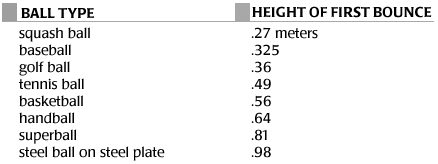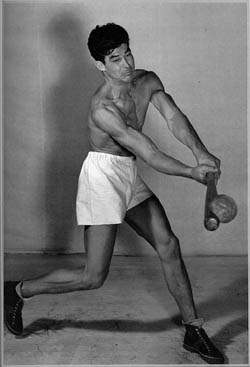|
Even a slight change in the bounciness of a baseball can
have a large effect on the game. A few years ago there was an unprecedented
rash of home runs in the major leagues. That year's crop of baseballs bounced
off the bats with unusual liveliness, turning what should have been long
outs into home runs. Everyone suspected that these baseballs had been particularly
tightly wound, producing so-called "rabbit" balls. (One disgruntled
pitcher said that you could hold one up to your ear and hear its little
heart beating a mile a minute.) If such a seemingly minor change could have
such a dramatic effect, it's not surprising that the bounciness of the tennis
ball completely transformed my childhood baseball game.
Dropping Balls
To begin your own investigation of the bounciness of balls,
you'll need several different kinds of balls to compare. I'd suggest a golf
ball, a tennis ball, a baseball, and a basketball for starters. Hold a ball
at a measured height above a solid surface-- one meter is a good height.
Now drop the ball and notice how high it bounces. Be sure that you measure
the starting height and the height of the bounce from the same point on
the ball--you can measure from the top, the bottom, or the center of the
ball, but be consistent. The table below shows a variety of balls and how
high they bounced when dropped from one meter above the ground.


|
To reverse the direction of a speeding softball, the
bat must push on it with eight thousand pounds of force. Imagine a ball
squashed under four tons of iron, and you'll understand why the softball
is deformed.
|
|
You can see why all these balls bounce by watching a ball
that bounces in slow motion--a water balloon. You'll need a few balloons
to get started--you might as well plan on breaking some. You'll break fewer
if you don't fill the balloon too full of water and if you use a double
balloon: lubricate the outside of one balloon with cooking oil, push it
into a second balloon, then fill the inner one with water.
Drop your double water balloon onto a smooth surface and watch what happens.
Notice that the bottom of the balloon comes to rest when the balloon hits
the floor, but the top keeps moving down. During the balloon's collision
with the floor, its rubber stretches as the balloon deforms from its initial
spherical shape. When the rubber elastically snaps back toward its original
dimensions, the balloon is pushed into the air.
|
|